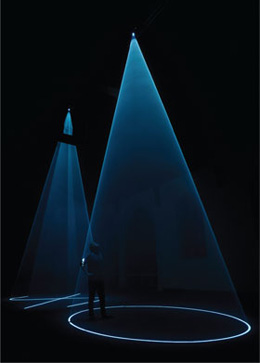Dream On
John Haberin New York City
Dreamlands: Immersive Cinema and Art
Pipilotti Rist: A Retrospective
Do people still go to the movies? Do you?
Oh, sure, I know they do. I know show times at the multiplex from the ebb and flow at a neighborhood bar across the street. Speaking for myself, though, I catch up on movies at home, with breaks for raiding the fridge and checking email—and the film plays on during the breaks. I am hardly alone, too, some would say.  Even those devoted to the movies may never see film classics on the big screen. Short of the sophisticated audience for film festivals, that experience may already belong to the past.
Even those devoted to the movies may never see film classics on the big screen. Short of the sophisticated audience for film festivals, that experience may already belong to the past.
At the Whitney, though, there is still a space for theater. "Dreamlands: Immersive Cinema and Art" argues for the power of the moving image to "influence how we see and experience the world." Little in it is immersive, and even less is cinema. Yet the entirety very much is. One can get lost in its maze of rooms, corridors, and images. One can step in a moment or two from one of the very first moving images, in 1905, to the twenty-first century, without batting an eye. And then one can argue over just how much has been lost in a dream.
As an afterword, whose art is more immersive than that of Pipilotti Rist—or her New Museum retrospective? For a time she was seemingly everywhere, on all sides, so let me also direct you to my earlier review of half a dozen appearances. There I cover eight years of video and mammoth installations, every one of them meant to draw you in for good. Here I stick to what for Rist is one extended dream. Who would want to wake up from the immersion? Is it a coincidence that Rist, in one work, breaks a few windows?
Utopia or nightmare
The Whitney's dream dates back to the twentieth century—and, like so much of Modernism, it could present a utopia or a nightmare. The curator, Chrissie Iles, nods to exactly two feature-length films. Both Fantasia, with Mickey as the sorcerer's apprentice, and Blade Runner think of the movies as the occasion for entertainment, fantasy, and art. And both see things as out of control. They serve as reference points for the show's contemporary work. Much of the rest amounts to how immersive cinema got there.
Both films turn up twice, among the thirty-eight projections and installations. Oskar Fischinger's drawings for Fantasia, around 1938, approach abstraction. If Disney rejected them as too arty, his own studio artists are no less impressive, with sketches for the creation of the world. Syd Mead supplies "concept paintings" for Blade Runner starting in 1980, and Terence Broad remembers its dystopia in 2016 in Autoencoded, his imagined neural network for artificial intelligence. If it sounds like the show leans toward sci-fi geeks, it does. And that leaves the question of how much the geeks can say about virtual reality—or, to put it quaintly, the real one.
"Dreamlands" provides space and time to ask. The display snakes around the museum's largest exhibition floor, with alcoves as miniature theaters. Chronology gives way at times to convenience, but the new Whitney in the Meatpacking District holds up. The third floor adds a film series, for those who really do go to the movies. An off-site program, "Dreamlands: Extended," runs at Microscope, the gallery for new media in Bushwick. Already, you may be wondering about the nature of immersion. With work of up to an hour in the core alone, almost no one will stay for it all.
Those limits have meaning, too, for they correspond to another common view of images today. If I started with one cliché, try another. The entire world, one hears, has become virtual, with everyone lost in a cell phone—even just across the table or walking down the street. AI will soon put everyone out of work, even Refik Anadol in new media. At the same time, people move casually from one reality to another. Think of my breaks for email.
"Dreamlands" can at times approach a cliché. If Blade Runner as cinema today were not enough, others fixate on anime. A solitary manga girl keeps busy for Pierre Huyghe in the ice mountains, for Dominique Gonzalez-Foerster in the rain, for Liam Gillick in a colorful aluminum Minimalism, for Melik Ohanian dreaming and dancing, for Rirkrit Tiravanija chasing ghosts, and for Philippe Parreno "anywhere out of the world." Enough, please. It can also leave one missing the point. I knew from his retrospective that Crossroads, by Bruce Conner, will break the surreal quiet for an atomic test explosion. Others may not stick around to find out.
Still, they might stick around, and they should. The show's theme could include anything and nothing. Plenty of others have offered takes on the origins of new media—and their implications. Just right now, the International Center of Photography dedicates its new home to the culture of data mining and surveillance. Pipilotti Rist at the New Museum has larger and more immersive installations. Yet for all that the Whitney has its explosions, and the whole is more than the sum of its parts.
The old song and dance
Actually, "Dreamlands" flirts only briefly with virtual reality. Trisha Baga supplies 3D glasses for Flatlands, a scenic tour of life forms and mirrored surfaces. So does Ben Coonley for Trading Futures, a lecture on the headlong rush toward a global economy set against a panoramic city. The show has only a lover's quarrel with art and AI as well, and it never mentions Harold Cohen and AARON. Ian Cheng has his "chat bots" and Lynn Hershman Leeson her alter-ego, played by Tilda Swinton, with such zingers as "Haven't we met?" Suddenly Siri sounds a lot smarter.
It hangs onto old media, with a pink and purple mural by Alex Israel, for whom the Web has taken on a physical presence—but then painting, too, has always asked for your full attention, on the scale of a gallery or a chapel. It has only a few immersive installations at that, and they come as high points. Coonley sets his trading floor under a geodesic dome, while actual film lies on the floor in front of images of destruction by Jud Yalkut. Just so you know, the Whitney singles that one out as a top pick for children. Alex Da Corte and Jayson Musson spill across four screens, front and back, for what they bill as an update of Thornton Wilder's Our Town, the 1938 play. I could not make the connection, but the slow-motion performance in an eerily clean environment comes not just with music, but also with scents.
 What the show does best is to break out of any one perspective, however virtual or real. It seeks out alternative histories—or what Michel Foucault would call geneologies of an idea. From the very first, it says, Modernism had its utopias and its nightmares. Edwin S. Porter captures Coney Island at night in 1905, at the very birth of motion pictures and electric lights, as a site of manufactured glory and artificial risks. Oskar Schlemmer in 1926 treats dancers as puppets, soldiers, or instruments of sheer delight for his Triadic Ballet. By then Oskar Fischinger is already putting firm in the service of geometric abstraction.
What the show does best is to break out of any one perspective, however virtual or real. It seeks out alternative histories—or what Michel Foucault would call geneologies of an idea. From the very first, it says, Modernism had its utopias and its nightmares. Edwin S. Porter captures Coney Island at night in 1905, at the very birth of motion pictures and electric lights, as a site of manufactured glory and artificial risks. Oskar Schlemmer in 1926 treats dancers as puppets, soldiers, or instruments of sheer delight for his Triadic Ballet. By then Oskar Fischinger is already putting firm in the service of geometric abstraction.
Joseph Cornell mines found footage for another endangered utopia—that of a child east of Borneo, in 1936. The shift to immersion picks up its pace with the golden age of television. Stan VanDerBeek has the first full-blown installation in 1968, with his stacked Movie Mural. Five years later, Anthony McCall lures one into a dark room broken by a pencil of light, which slowly grows to describe a cone and to encompass the viewer. It looks ahead to Josiah McElheny, Aidan Koch, Andrea Crespo, or Jenny Perlin painting with light. It looks ahead, too, to Artie Vierkant, who obliges one to stare at a sunset until it surpasses the real.
Has dusk, too, succumbed to short attention spans and virtual reality? I could venture an answer, but "Dreamlands" has little in the way of politics, apart from Lorna Mills revisiting art history or Ivana Basic her body. Frances Bodomo's Afronauts worries less about Zambia as a young nation than whether it will win the space race. The exhibition treats cinema as the occasion for art. Two of its most immersive moments even verge on the politically incorrect. They also turn to song and dance.
Hito Steyerl marks the way into his theater with a wall and floor grid, as the tools and the site of computer-assisted design. On video, in a virtual living room, a cop, a robot, and workers under duress burst into dance. If Steyerl masks a serious critique, Mathias Poledna looks back to a more idyllic past. In his hand-drawn animation, a donkey overcomes its loneliness with a song. It recalls Disney, pop music from the 1930s, and song-and-dance men in blackface, but somehow it also knows better and hits home. Now excuse me while I check email and raid the fridge.
Slipping Away
So there you are again, Pipilotti, if not at the Whitney, your face pressed ever so close, even as your body slips away. There you are, the image more than a little off-kilter, like everything about you. There you are, too, floating in a boundless sky or sea. You are inviting me in there with you, while laughing at us both for how hard you are to resist. You have a caustic side as well, for all the temptations—with who knows what lurking in the background. Is that why they call new media the cutting edge?
For a while, Pipilotti Rist was everywhere—and not just within her seductive videos. She had quite a run of them at that, culminating in "Pour Your Body Out (7354 Cubic Meters)," which took over MoMA's atrium in 2008. They seem not to need a beginning or ending, much like her slow-motion stroll in heels along a city street, smashing car windows with an iron rod disguised as a flower along the way. And in truth nothing much has changed since then, with little if anything from recent years.  The New Museum simply picks up where she left off floating and dancing. The work is much the same as ever, only bigger, from an artist who always thinks big.
The New Museum simply picks up where she left off floating and dancing. The work is much the same as ever, only bigger, from an artist who always thinks big.
A lot bigger. She has the run of all three floors for big exhibitions, plus the lobby, where a machine blows extra large soap bubbles. And her feel-good retrospective approaches a prolonged bubble bath—or a single installation. As "Pixel Forest," it dares one to locate the work, to put it in chronological order, or to know where any of it begins and ends, apart from which come with soft carpeting and still softer beanbag chairs. Even the earliest videos, restricted to a single channel and a monitor, are immersive. Acting as curators, Massimiliano Gioni, Margo Norton, and Helga Christoffersen place them in soundproofed shells for viewers to insert their head.
Yet even that picks up where she left off. To the extent that Rist's career has a trajectory, it is all about getting bigger. She gained recognition in 1986, already up close and askew, reciting "I'm not the girl who misses much"—appropriating the Beatles, from "Happiness Is a Warm Gun," for herself. Things grew slower, like her urban walk from 1997, and larger, like the twin corner projections of Sip My Ocean from 1996 or all those cubic meters. Videos soar across landscapes that recall her native Switzerland. They also add furniture to make yourself at ease along the way.
They add, too, a miniature sound studio on video and an entire model city, in person. A chandelier of underwear defies the debate over boxers or briefs, but then she is inviting you to laugh, too. Curtains of lights switch from bubbles of white in the darkness to oceans of red and green. One must pass through curtains of plastic strips, and so must a projection. The equation of the viewer with the projection adds to its temptations. The Whitney does not include Rist in its concurrent show of "Immersive Cinema," but it could.
A new work even provides beds. By the time I made it upstairs, people were already stretched out. Had they spent the night there, or were they only mannequins—or dead? Nope, but neon signs in script shout Help Me and Hurt Me from opposite ends of the floor. Is Rist more soothing, more childish, or more threatening than ever? Maybe only a little, on all three counts, but your own body will not so easily slip away.

"Dreamlands: Immersive Cinema and Art" ran at The Whitney Museum of American Art through February 5, 2016, Pipilotti Rist at the New Museum through January 15. A related review follows Rist over eight years.




